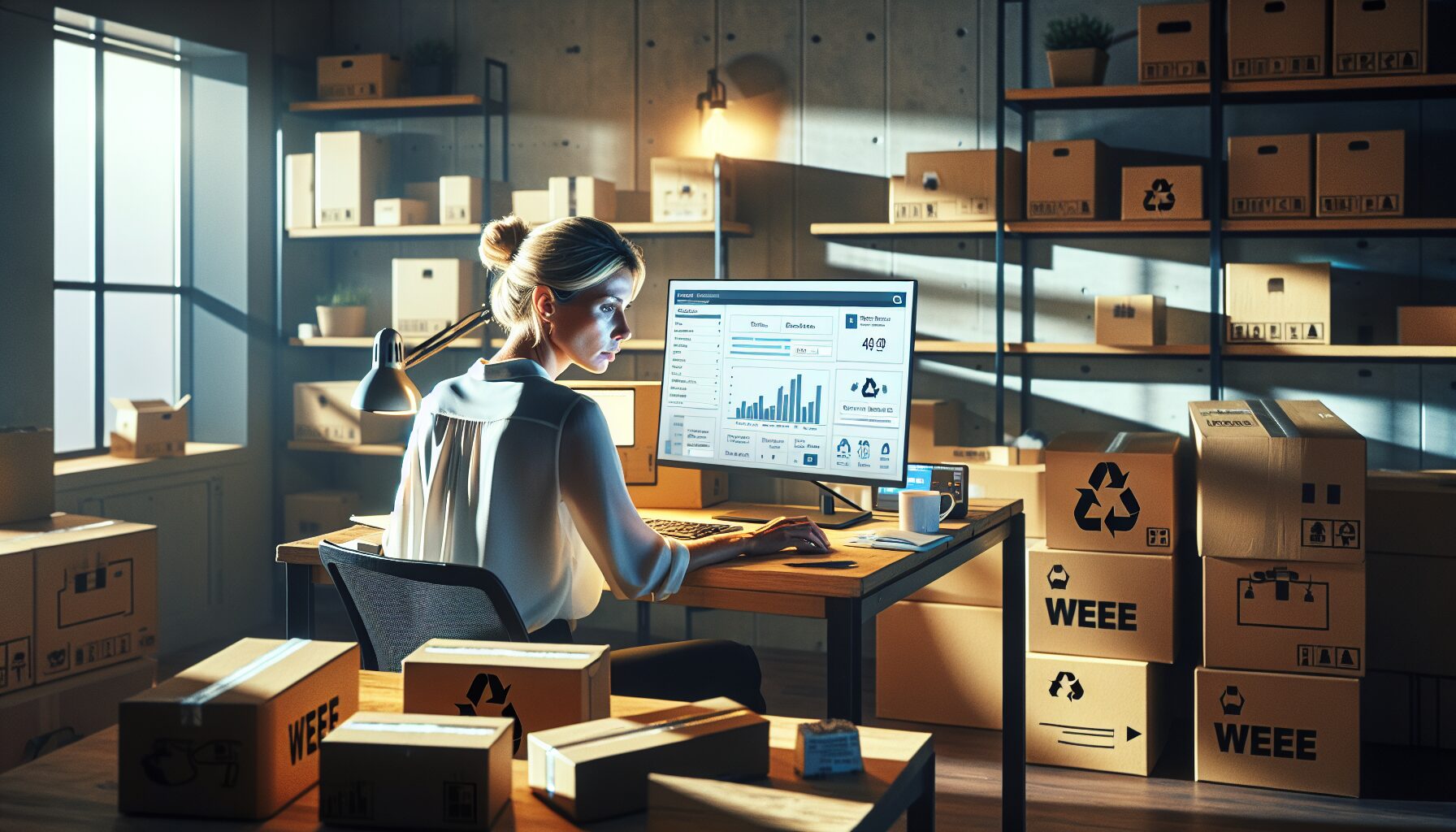About eldris
At Eldris, we automate SEO, multilingual site expansion, and EU compliance for brands scaling across Europe. Our AI-powered platform handles everything from content publishing to regulatory docs—so you don’t have to.
In This Article
- Packaging compliance and WEEE apply to all sellers entering or operating within EU markets.
- Packaging focuses on material format; WEEE focuses on the electronic product lifecycle.
- Extended Producer Responsibility rules require registration, reporting, and eco-contributions.
- Each EU state enforces laws differently—one-size-fits-all strategies won’t work.
- Automation platforms can dramatically simplify multinational compliance efforts.
- Common pitfalls include failing to register correctly or underreporting packaging data.
- Upcoming 2025 rules will increase obligations; now is the time to act.
Understanding Packaging Compliance for Global Sellers
The Role of Packaging Laws in the EU
Packaging compliance is a regulatory cornerstone for global sellers operating in the European market. At its core, it refers to ensuring that all packaging placed on the market adheres to legal requirements established by directives such as the EU Packaging and Packaging Waste Directive (PPWD). Non-compliance may result in blocking market access, financial penalties, or product recalls. Consequently, compliance is more than a bureaucratic obligation—it’s essential for brand reputation, legal stability, and operational continuity.
The PPWD outlines specific obligations for producers, importers, and distributors, requiring them to minimise the environmental impact of packaging. Businesses must register with national authorities, report volumes of packaging material placed on the market, and pay fees for waste collection and recycling efforts. Compliant packaging must be recyclable, minimised in weight and volume, and free from harmful substances like heavy metals. Sellers targeting multiple EU nations must also adapt to varying national interpretations of the directive, complicating compliance for cross-border traders.

Clarifying What WEEE Really Means
Scope of WEEE Regulations and Who Must Comply
The Waste Electrical and Electronic Equipment (WEEE) Directive governs the end-of-life management of electronic devices across the European Union. While packaging compliance deals strictly with the materials used to protect and present a product, WEEE looks at the device itself. Sellers of electronics must ensure that their goods can be collected, treated, recycled, and environmentally disposed of, once the end-user discards them.
WEEE applies to producers who manufacture, import, or distribute electrical and electronic equipment (EEE) in the EU. Registration with local WEEE schemes per country is required, alongside regular reporting of units placed on the market. Significantly, even non-European sellers listing on EU-based marketplaces such as Amazon or eBay are responsible for meeting WEEE responsibilities. If you are a producer by definition, you must finance end-of-life take-back and recycling services for your products. This compliance step is not optional and applies regardless of your onsite presence in the EU.
Packaging vs. WEEE – What’s the Core Difference?
Material Type, End-of-Life Responsibility, and Enforcement
Although packaging compliance and WEEE intersect in environmental intent, they function on entirely different regulatory planes. Packaging compliance focuses on the physical packaging material, such as boxes, foils, films, trays, and protective inserts. WEEE, in contrast, governs the electronic unit inside that packaging. The legal definitions and targeted materials under each directive are fundamentally different, as are the methods of enforcement and producer responsibilities.
In packaging, a central goal is to reduce excess waste before it even exists. Hence, ecodesign principles and weight thresholds play key roles. On the other hand, WEEE aims to mitigate the environmental burden post-consumer use via take-back services, proper dismantling, and material recovery. Enforcement bodies also vary: packaging compliance may fall under environmental or waste management authorities, while WEEE is often overseen by dedicated electronic waste agencies. The distinctions are critical for sellers seeking to avoid legal duplication or, worse, overlook part of their obligation entirely.
Where the Two Regulations Overlap
Electronic Devices with Complex Packaging
Where the real complexity starts is in the intersection of WEEE and packaging compliance. Electronic goods often come with several layers of packaging—external boxes, internal foam mouldings, user manuals, cable organisers, plastic bags, and stickers. For comprehensive regulatory fulfilment, the global seller must evaluate both the device and the packaging components separately.
This overlap requires meticulous classification and double-pronged registration. You may need to report kilograms of cardboard under your packaging submission and simultaneously categorise your USB-powered device under WEEE categories like “small IT equipment.” In some local markets like Germany or France, failure to submit these reports correctly feeds directly into e-commerce enforcement platforms. That means unregistered products may effectively be banned from digital shelves. This dual scrutiny heightens administrative burden and calls for automated compliance systems to handle classification, registration, and reporting tasks. Learn more about EU Compliance for Global E-Commerce
Extended Producer Responsibility (EPR) in Practice
How EPR Mandates Affect Sellers
Extended Producer Responsibility, or EPR, underpins both packaging and WEEE regimes. It places the onus on producers to finance and organise the entire lifecycle of the product and its materials—collection, recycling, and even public awareness in some cases. Introduced to shift the environmental burden away from governments and towards those placing goods into circulation, EPR is now legally binding in nearly every EU member state.
Sellers must register with authorities, detail the types of goods they sell, and pay eco-contributions based on volumes and product types. For packaging compliance, fees are typically calculated based on material weight and recyclability. For WEEE, fees may depend on factors such as device category, hazard class, and design complexity. Penalties for non-compliance range from several thousand euros to criminal prosecution in extreme cases. Marketplaces like Amazon now require proof of EPR registration before allowing product listings in certain categories, making compliance not just necessary but critical for revenue continuity. Definition of WEEE and EEE in regulations
“EPR has fundamentally reshaped how businesses think about environmental responsibility. It’s not just legislation; it’s a transformational business model.”
EU Country-by-Country Compliance Variations
Why One Market’s Rules Don’t Apply to All
One of the biggest traps global sellers fall into is assuming harmonisation across the European Union. While EU directives like WEEE and PPWD set baseline principles, each country transposes these directives into national law in vastly different ways. This leads to a patchwork quilt of reporting obligations, fee structures, and administrative processes that businesses must navigate with surgical precision.
In France, for example, EPR reporting for packaging may involve declaring your logos and having bilingual labelling. In contrast, Germany’s packaging rules—spearheaded by the VerpackG law—are far stricter about volume thresholds and pre-market registration. Italy imposes eco-modulated fees based on how well your packaging can be dismantled and sorted. Spain recently revised its EPR scope to include commercial and industrial packaging obligations. This diversity demands either country-specific experts or SaaS automation platforms that house a unified dashboard across multiple jurisdictions. Read a related article
Packaging and WEEE Compliance Automation
Driving Efficiency Through SaaS Platforms
Maintaining packaging compliance and WEEE regulations manually across borders is no longer viable for competitive sellers. That’s where software-as-a-service (SaaS) platforms come in. These tools help international sellers streamline their regulatory obligations through automation, multilingual interfaces, and built-in reporting frameworks aligned with national databases.
For instance, these tools can automate producer registration, assign product categorisations, calculate fees, and even alert sellers of upcoming regulatory updates in real-time. Some solutions also integrate directly with e-commerce platforms to prevent SKU listings that lack proof of compliance documentation. As a result, adoption of compliance automation can reduce administrative costs, improve accuracy, and eliminate cross-border compliance bottlenecks. Systems like these are no longer a luxury but a necessity for brands looking to expand swiftly without regulatory friction. 2025 packaging EPR deadlines for sellers
Common Seller Pitfalls and How to Avoid Them
Lack of Registration, Incomplete Reporting
Non-compliance often originates from simple oversights. A seller might assume packaging reporting is covered under WEEE submissions or might grossly underestimate the material weights requiring declaration. Another common error is failing to register as a “producer” in multiple countries, especially for platforms operating warehouse-to-customer models in pan-European networks.
Incomplete reporting is just as dangerous. Under-reporting packaging volumes or WEEE units can trigger audits, fines, and even blacklisting from established marketplaces. Sellers reliant on third-party logistics (3PL) providers often assume compliance is delegated when in fact it is the producer—not the shipper—who holds legal liability. To avoid these pitfalls, conduct regular audits of your product categories, packaging materials, and sales jurisdictions. Partner with specialist compliance agencies if necessary, and integrate automated tracking systems to ensure 100% transparency in reporting.
The Road Ahead: 2025 Compliance Deadlines
What Global Sellers Must Do Now
The regulatory landscape for packaging and WEEE is tightening, with several key changes on the horizon for 2025. The European Commission is set to update both the Packaging and Packaging Waste Regulations (PPWR) and the WEEE Directive, potentially including reuse quotas, QR code labelling, and stricter audit trails for EPR declarations. This evolution will increase both the volume and complexity of compliance tasks expected of producers, merchants, and global sellers alike.
To prepare, forward-thinking sellers should invest in compliance intelligence tools and ensure their operational models allow for per-market customisation. Building relationships with national producer responsibility organisations (PROs) now can ease registration burdens later. Above all, early action allows room for strategic planning rather than reactive scrambling in the face of new compliance enforcement actions. For sellers invested in growth across Europe and beyond, the cost of early compliance is minimal compared to the cost of being barred from the market altogether.
Conclusion: Uniting Packaging and WEEE for Global Growth
Packaging compliance and WEEE obligations may appear to be two distinct regulatory silos, but for global sellers, they form a critical duo that guarantees operational continuity, legal congruency, and environmental stewardship in key markets. Navigating this terrain requires long-term thinking, country-specific adaptations, and—most importantly—robust systems built to scale compliance across territories. By embracing automation, educating internal teams, and acting well ahead of 2025 revisions, retailers can align their sustainability objectives with market access imperatives. Make no mistake: compliance is more than just checkmarks in boxes—it’s your passport to sustainable, profitable growth worldwide.
Great guide on packaging-weee-differences-global-sellers – Community Feedback
What is the main difference between Packaging and WEEE regulations?
Packaging regulations target the recycling and management of all packaging waste, while WEEE regulations specifically address the collection, recovery, and recycling of electronic and electrical equipment at the end of its life.
Does my product need to comply with both Packaging and WEEE?
If you sell electrical or electronic goods in the EU that are packaged, you likely must comply with both Packaging and WEEE rules, ensuring processes for recycling both product waste and packaging materials.
How does EPR affect global sellers in Europe?
Extended Producer Responsibility (EPR) makes global sellers legally responsible for financing the collection and recycling of their products and packaging, requiring registration, reporting, and compliance in each relevant EU market.








